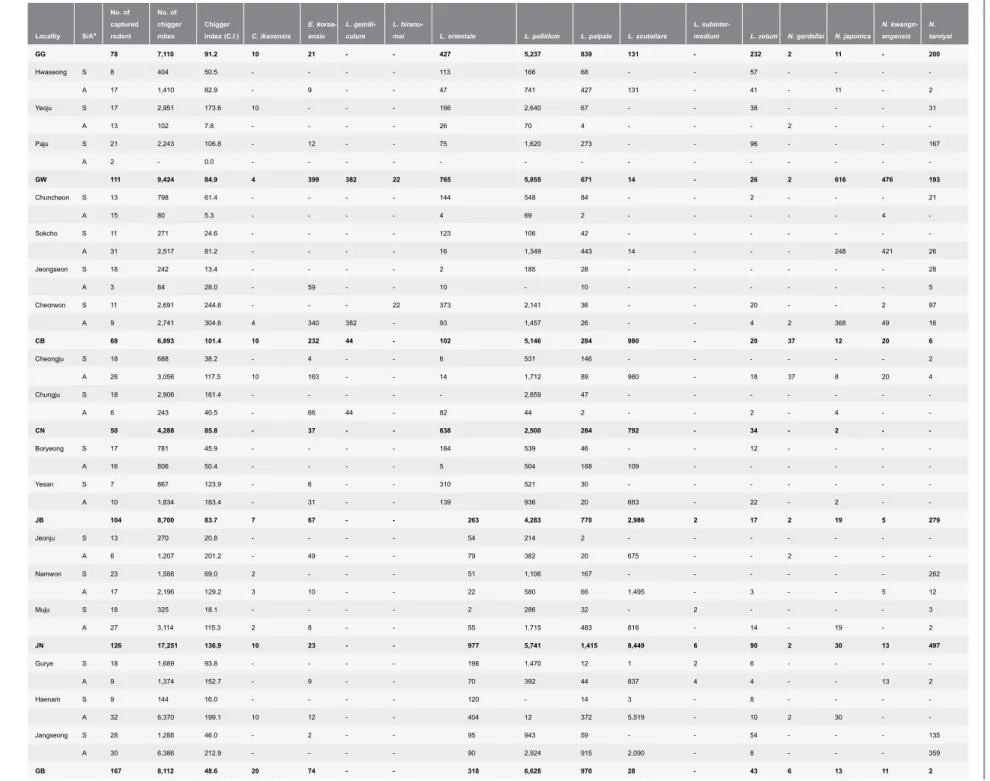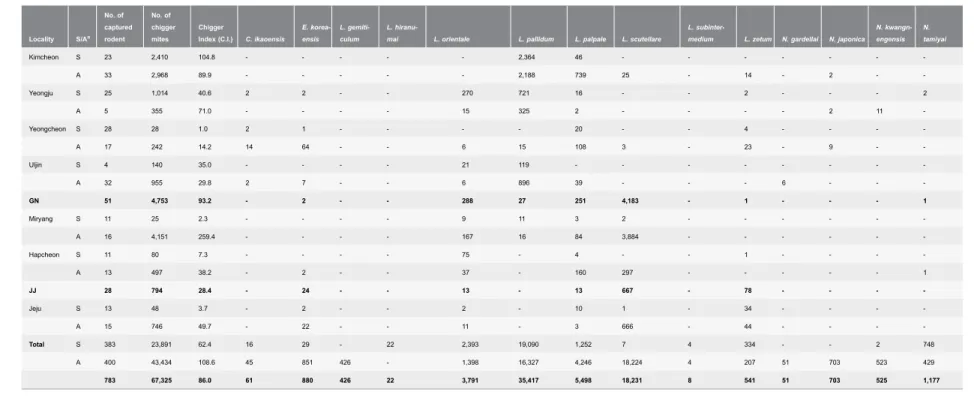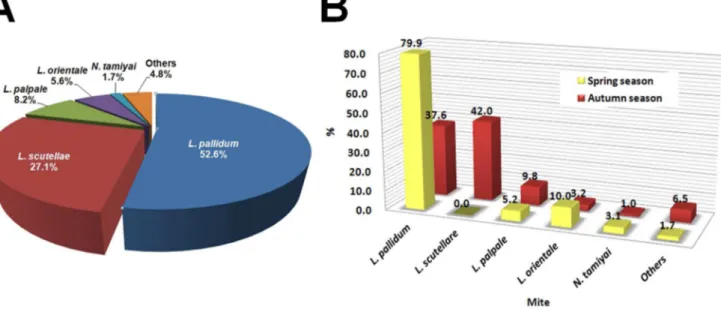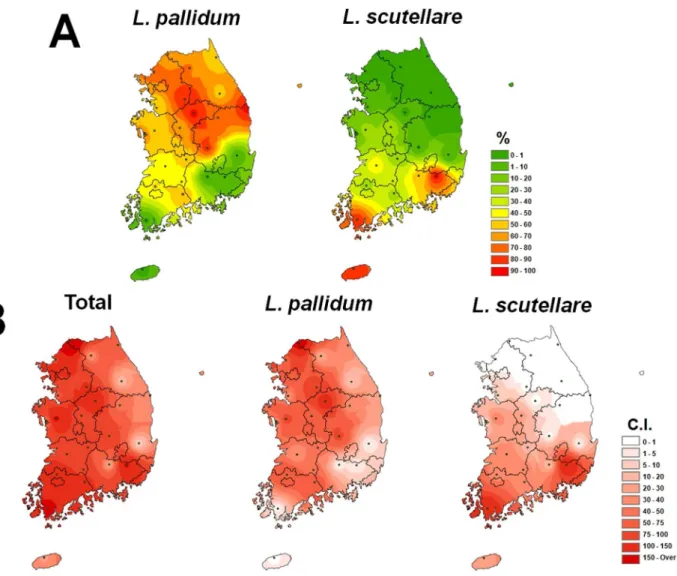RESEARCH ARTICLE
Coincidence between Geographical
Distribution of
Leptotrombidium scutellare
and Scrub Typhus Incidence in South
Korea
Jong Yul Roh1, Bong Gu Song1, Won Il Park1, Eun Hee Shin1, Chan Park2, Mi-Yeoun Park1, Kyu Sik Chang1, Wook Gyo Lee1, Hee Il Lee3, E-Hyun Shin1*
1.Division of Medical Entomology, Center for Immunology and Pathology, Korea National Institute of Health, Cheongju, Korea,2.Division of Arboviruses, Center for Immunology and Pathology, Korea National Institute of Health, Cheongju, Korea,3.Division of Biosafety Evaluation and Control, Korea National Institute of Health, Cheongju, Korea
*ehshin@nih.go.kr
Abstract
To clarify the geographical distribution of scrub typhus vectors in Korea, a survey of larval trombiculid mites was conducted from 2005 to 2007 by collecting wild small mammals twice a year (spring and autumn) at 24 sites nationwide. A total of 67,325 mites representing 4 genera and 14 species were collected from 783 trapped rodents, corresponding to a chigger index (number of chigger mites per rodent) of 86.0. The predominant mite species were Leptotrombidium pallidum (52.6%),
Leptotrombiduim scutellare (27.1%),Leptotrombidium palpale(8.2%),
Leptotrombidium orientale(5.6%), andNeotrombicula tamiyai(1.7%). However, the
proportions ofL. scutellarein southern areas, including endemic provinces such as Jeollabuk-Do (34.3%), Jeollanam-Do (49.0%), and Gyeongsangnam-Do (88%), were relatively higher than in central Korean regions where L. pallidumwas predominant. In autumn, the ratio ofL. scutellareincreased to 42% while the ratio of
L. pallidum decreased. The geographical distribution map of theL. scutellare
chigger index was identical to the incidence pattern of scrub typhus, whereas those of overall mites and L. pallidumshowed no relationship with case incidence patterns. Distribution mapping analysis shows an identical geographical distribution
ofL. scutellareand epidemic incidence of scrub typhus in South Korea.L. pallidum
could be another vector at all other parts of the Korean peninsula, including the eastern and northern regions that have a low level of scrub typhus incidence.
OPEN ACCESS
Citation:Roh JY, Song BG, Park WI, Shin EH, Park C, et al. (2014) Coincidence between Geographical Distribution ofLeptotrombidium scu-tellareand Scrub Typhus Incidence in South Korea. PLoS ONE 9(12): e113193. doi:10.1371/ journal.pone.0113193
Editor:Xue-jie Yu, University of Texas Medical Branch, United States of America
Received:April 10, 2014
Accepted:September 4, 2014
Published:December 12, 2014
Copyright:ß2014 Roh et al. This is an open-access article distributed under the terms of the
Creative Commons Attribution License, which permits unrestricted use, distribution, and repro-duction in any medium, provided the original author and source are credited.
Data Availability:The authors confirm that all data underlying the findings are fully available without restriction. All relevant data are within the paper.
Funding:This work was supported by Korea Centers for Disease Control and Prevention under the budget for health promotion (No. 4800-4851-300). The funders had no role in study design, data collection and analysis, decision to publish, or preparation of the manuscript.
Competing Interests:The authors have declared that no competing interests exist.
Introduction
Scrub typhus (tsutsugamushi disease) is caused by the rickettsial bacterium,
Orientia tsutsugamushi, which are transmitted through bites from infected larval trombiculid mites [1].Orientia tsutsugamushi is maintained in mite populations by transovarial transmission [2,3].
In South Korea, scrub typhus is an acute febrile disease most common in the autumn months; the annual case number has fluctuated around 5,000
(approximately 10 per 100,000 persons) since 2004 [4]. As a reportable disease, confirmed cases of scrub typhus have been reported to Korea Centers for Disease Control and Prevention (KCDC) by the National Notifiable Disease Surveillance System since 1994. In 2013, 10,365 cases were reported nationwide; the highest number ever recorded, this total represents a 38.1-fold increase compared to 274 cases reported in 1995 [5]. Over 90% of cases were reported during the epidemic period, from October to November [4,6].
Known vector species of chigger mites includeLeptotrombidium akamushi, L. pallidum, L. scutellare, L. deliense, andL. imphalum in Japan, Taiwan, Thailand, and China, respectively [7,8,9,10]. Ree et al. (1991) first reportedL. pallidumas a vector in Korea, with an infection rate of 0.4% in 447 tested mites [11].L. scutellare is another key vector, with an infection rate of 0.5% [12]. The O. tsutsugamushibacterium has also been detected inL. palpale,L. orientale,L. zetum,
Neotrombicula japonica and Euschoengastia koreaensis chigger mites [13,14]. The distribution of chigger mites in Korea has been mainly surveyed in epidemic regions, such as Jeollanam-do, Gyeonggi-do, and Chungcheongnam-do [3,15,16]. A 2006 survey of 13 localities in Korea from October to November was the first nationwide survey [17].
In this study, we surveyed 24 localities nationwide in spring and autumn from 2005 to 2007 and analyzed the relationship between trombiculid mite
geographical distribution and scrub typhus epidemic regions in Korea.
Materials and Methods
Surveillance localities and periods
Larval trombiculid mites were collected from wild rodents captured at 24 sites nationwide from 2005 to 2007 (Fig. 1 andS1 Table). Collections were performed at each location in spring (March–May) and autumn (October–November). Collection information, including locality, collection year and month, number of traps installed, and number of rodents captured, is summarized in S1 Table. Rodent trap install sites included rice fields, cropped fields, reservoirs, waterways, hillsides, grass fields and riversides.
Collection of small mammals and chigger mites
The animal protocol used in this study was reviewed and approved based on ethical procedures and scientific care by the KCDC-Institutional Animal Care and
L. scutellareand Scrub Typhus Distributions
Use Committee (KCDC-IACUC; KCDC-046-13-2A). There was no need for specific permission for each collecting site, because these sites were not located at national parks or protected areas. The selection of collecting sites was supported by each local Public Health Center. The collected rodents were not the endangered or protected species in Korea.
The collection of small mammals was performed at 24 collection sites nationwide. A total of 10 to 15 Sherman live folding traps (36369 inches), Fig. 1. Scrub typhus surveillance in the Korean peninsula.Dots indicate nationwide surveillance locations. Each name indicates a city level locality (Si, -Gun, and -Gu in the Korean administrative area system). Province abbreviations: GG, Gyeonggi-Do; GW, Gangwon-Do; CB, Chungcheongbuk-Do; CN, Chungcheongnam-Do; GB, Gyeongsangbuk-Do; GN, Gyeongsangnam-Do; JB, Jeollabuk-Do; JN, Jeollanam-Do; JJ, Jeju-Do.
doi:10.1371/journal.pone.0113193.g001
L. scutellareand Scrub Typhus Distributions
baited with a peanut butter spread biscuit, were set up at five to seven points in the collection site at 3–5 m intervals and collected the next morning. Collected wild rodents were euthanized by compressed carbon dioxide (CO2). The wild
rodent corpses were hung over glass bowls filled with tap water for 24 h to collect dropped chigger mites. Chigger mites were recovered from the water surface with a fine brush and stored at 4
˚
C for further identification.Identification of chigger mites
Individual chigger mites were transferred to glass slides and mounted with PVA MTNG medium (Polyvinyl alcohol mounting medium, Bioquip). The specimens were identified to species level under stereo-microscopic examination using morphological keys [18].
ArcGIS geographical analysis
To compare the geographical distribution of vectors, distribution maps were drawn by interpolation using the IDW (Inverse Distance Weighted) technique among Spatial Analyst Tools in ArcGIS 9.0 (2004. Environmental Research Systems Institute, Redlands, CA, USA). Information about patients in South Korea diagnosed with scrub typhus in 2007 was obtained from the National Notifiable Disease Web Statistics System (NNDWSS) of the KCDC (Fig. 2A). Scrub typhus was diagnosed by indirect immune-fluorescent assay and nested polymerase chain reaction (PCR) by regional Institutes of Health and
Environment and hospitals and reported to the NNDWSS of the KCDC.
Fig. 2. Scrub typhus incidence in 2007 (A), and average monthly number of patients with scrub typhus (B) from 2001 to 2010.The figure is generated using data from the National Notifiable Disease Web Statistics System (NNDWSS) of the KCDC. Percentage (%) indicates monthly incidence rate.
doi:10.1371/journal.pone.0113193.g002
L. scutellareand Scrub Typhus Distributions
Table 1.Species of chigger mites from small mammals collected through the nationwide survey in South Korea.
Locality S/Aa No. of captured rodent No. of chigger mites Chigger
Index (C.I.) C. ikaoensis E.
korea-ensis L.
gemiti-culum
L.
hiranu-mai L. orientale L. pallidum L. palpale L. scutellare
L.
subinter-medium L. zetum N. gardellai N. japonica N.
kwangn-engensis N.
tamiyai
GG 78 7,110 91.2 10 21 - - 427 5,237 839 131 - 232 2 11 - 200
Hwaseong S 8 404 50.5 - - - - 113 166 68 - - 57 - - - -A 17 1,410 82.9 - 9 - - 47 741 427 131 - 41 - 11 - 2 Yeoju S 17 2,951 173.6 10 - - - 166 2,640 67 - - 38 - - - 31
A 13 102 7.8 - - - - 26 70 4 - - - 2 - - -Paju S 21 2,243 106.8 - 12 - - 75 1,620 273 - - 96 - - - 167
A 2 - 0.0 - - -
-GW 111 9,424 84.9 4 399 382 22 765 5,855 671 14 - 26 2 616 476 193
Chuncheon S 13 798 61.4 - - - - 144 548 84 - - 2 - - - 21 A 15 80 5.3 - - - - 4 69 2 - - - 4 -Sokcho S 11 271 24.6 - - - - 123 106 42 - - - -A 31 2,517 81.2 - - - - 16 1,349 443 14 - - - 248 421 26 Jeongseon S 18 242 13.4 - - - - 2 185 28 - - - 28 A 3 84 28.0 - 59 - - 10 - 10 - - - 5 Cheorwon S 11 2,691 244.6 - - - 22 373 2,141 36 - - 20 - - 2 97
A 9 2,741 304.6 4 340 382 - 93 1,457 26 - - 4 2 368 49 16
CB 68 6,893 101.4 10 232 44 - 102 5,146 284 980 - 20 37 12 20 6
Cheongju S 18 688 38.2 - 4 - - 6 531 146 - - - 2 A 26 3,056 117.5 10 163 - - 14 1,712 89 980 - 18 37 8 20 4 Chungju S 18 2,906 161.4 - - - 2,859 47 - - - -A 6 243 40.5 - 66 44 - 82 44 2 - - 2 - 4 -
-CN 50 4,288 85.8 - 37 - - 638 2,500 284 792 - 34 - 2 -
-Boryeong S 17 781 45.9 - - - - 184 539 46 - - 12 - - - -A 16 806 50.4 - - - - 5 504 188 109 - - - -Yesan S 7 867 123.9 - 6 - - 310 521 30 - - - -A 10 1,834 183.4 - 31 - - 139 936 20 683 - 22 - 2 -
-JB 104 8,700 83.7 7 67 - - 263 4,283 770 2,986 2 17 2 19 5 279
Jeonju S 13 270 20.8 - - - - 54 214 2 - - - -A 6 1,207 201.2 - 49 - - 79 382 20 675 - - 2 - - -Namwon S 23 1,588 69.0 2 - - - 51 1,106 167 - - - 262
A 17 2,196 129.2 3 10 - - 22 580 66 1,495 - 3 - - 5 12 Muju S 18 325 18.1 - - - - 2 286 32 - 2 - - - - 3
A 27 3,114 115.3 2 8 - - 55 1,715 483 816 - 14 - 19 - 2
JN 126 17,251 136.9 10 23 - - 977 5,741 1,415 8,449 6 90 2 30 13 497
Gurye S 18 1,689 93.8 - - - - 198 1,470 12 1 2 6 - - - -A 9 1,374 152.7 - 9 - - 70 392 44 837 4 4 - - 13 2 Haenam S 9 144 16.0 - - - - 120 - 14 3 - 8 - - - -A 32 6,370 199.1 10 12 - - 404 12 372 5,519 - 10 2 30 - -Jangseong S 28 1,288 46.0 - 2 - - 95 943 59 - - 54 - - - 135
A 30 6,386 212.9 - - - - 90 2,924 915 2,090 - 8 - - - 359
GB 167 8,112 48.6 20 74 - - 318 6,628 970 28 - 43 6 13 11 2
Table 1.Cont.
Locality S/Aa No. of captured rodent No. of chigger mites Chigger
Index (C.I.) C. ikaoensis E.
korea-ensis L.
gemiti-culum
L.
hiranu-mai L. orientale L. pallidum L. palpale L. scutellare
L.
subinter-medium L. zetum N. gardellai N. japonica N.
kwangn-engensis N.
tamiyai
Kimcheon S 23 2,410 104.8 - - - 2,364 46 - - - -A 33 2,968 89.9 - - - 2,188 739 25 - 14 - 2 - -Yeongju S 25 1,014 40.6 2 2 - - 270 721 16 - - 2 - - - 2 A 5 355 71.0 - - - - 15 325 2 - - - - 2 11 -Yeongcheon S 28 28 1.0 2 1 - - - - 20 - - 4 - - - -A 17 242 14.2 14 64 - - 6 15 108 3 - 23 - 9 - -Uljin S 4 140 35.0 - - - - 21 119 - - - -A 32 955 29.8 2 7 - - 6 896 39 - - - 6 - -
-GN 51 4,753 93.2 - 2 - - 288 27 251 4,183 - 1 - - - 1
Miryang S 11 25 2.3 - - - - 9 11 3 2 - - - -A 16 4,151 259.4 - - - - 167 16 84 3,884 - - - -Hapcheon S 11 80 7.3 - - - - 75 - 4 - - 1 - - - -A 13 497 38.2 - 2 - - 37 - 160 297 - - - 1
JJ 28 794 28.4 - 24 - - 13 - 13 667 - 78 - - -
-Jeju S 13 48 3.7 - 2 - - 2 - 10 1 - 34 - - - -A 15 746 49.7 - 22 - - 11 - 3 666 - 44 - - -
-Total S 383 23,891 62.4 16 29 - 22 2,393 19,090 1,252 7 4 334 - - 2 748 A 400 43,434 108.6 45 851 426 - 1,398 16,327 4,246 18,224 4 207 51 703 523 429
783 67,325 86.0 61 880 426 22 3,791 35,417 5,498 18,231 8 541 51 703 525 1,177
aS or A indicates spring season or autumn season.
Results and Discussion
A total of 5,538 traps were installed and 783 wild rodents captured at 24 regions in 9 South Korean provinces (S1 Table). The overall trapping rate was 14.1; the highest trapping rate (30.5%) was recorded in riverside locations. Among trapped rodents, Apodemus agrariuswas dominant in all regions, accounting for 87.4% of the collections (data not shown), followed by Crocidura lasiura and Micromys minutus at 8.0% and 4.2%, respectively. From those rodents, 67,325 mites representing 4 genera and 14 species were collected, with a chigger index (C.I., number of chigger mites per rodent) of 86.0 (Table 1). The number and C.I. (43,434 and 108.6) of chigger mites in autumn were 1.8-fold and 1.7-fold higher than in spring (23,891 and 62.4). This result suggests that the high density of chigger mites may affect the high incidence rate (92.3%) of scrub typhus in autumn. In South Korea, the incidence of scrub typhus is generally highest during autumn (over 90%), from September to November, while the incidence in other seasons (spring, summer and winter) ranged from 0.1 to 0.3% (Fig. 2B).
However, the difference in chigger indices between spring and autumn does not proportionally explain the difference in scrub typhus incidence in the same seasons.
The predominant species identified in this study wereLeptotrombidium pallidum(52.6%),L. scutellare(27.1%),L. palpale(8.2%),L. orientale(5.6%), and
Neotrombicula tamiyai (1.7%) (Fig. 3A). This finding is similar to a previous report [17]: Lee et al. (2009) found L. pallidumto be the dominant species (74.9%), followed byL. scutellare(18.9%) andL. palpale(2.7%). Lee et al. further showed that L. pallidum andL. scutellare are the predominant scrub typhus
Fig. 3. Total percentages (A) and seasonal prevalence (B) of chigger mites collected through Korean national surveys between 2005 and 2007.
‘‘Others’’ indicates 9 minor species includingE. koreaensis.
doi:10.1371/journal.pone.0113193.g003
L. scutellareand Scrub Typhus Distributions
vectors, accounting for approximately 90% of the chigger mite population in Korea. In autumn, the ratio of L. scutellare increased to 42.0% whileL. pallidum
decreased to 37.6% (Fig. 3B).L. palpale density also increased 5.2% to 9.8% in autumn. The increased density of L. scutellareand L. palpalemay affect the high autumn incidence of scrub typhus (Fig. 3B). In Korea, spring is the only seeding season, while autumn is the main harvest season. Therefore, the highL. pallidum
population without corresponding scrub typhus case increases in spring may be explained by seasonal differences in human behavior patterns that limit human exposure to L. pallidum in spring.
The highest C.I. was recorded in Jeollanam-Do (JN, 136.9) among 9 provinces, followed by Chungcheongbuk-Do (CB, 101.4), and Gyeongsangnam-Do (GN, 93.2) (Table 1). However, the regions with the highest average incidence over three years (2005 to 2007) were Jeollabuk-Do (JB), Chungcheongnam-Do (CN) and Jeollanam-Do (JN). The prevalence of L. scutellarein southern areas, including endemic provinces such as Jeollabuk-Do (2,986, 34.3%), Jeollanam-Do
Fig. 4. Geographical distribution of chigger mites.The map color indices differ between the total number (0– over 5,000) and species maps (0– over 2,000).
doi:10.1371/journal.pone.0113193.g004
L. scutellareand Scrub Typhus Distributions
(8,449, 49.0%), and Gyeongsangnam-Do (4,183, 88%) was relatively higher than in the central areas where L. pallidumwas predominant.
To visualize the geographical distribution of chigger mites in South Korea, we analyzed collection data using the interpolation method of the IDW tool in the ArcGIS program. We first drew distribution maps based on the number of chigger mites for the five predominant species (Fig. 4). L. pallidum, L. palpale andL. orientale were evenly distributed nationwide. However, L. scutellare was found in the western and southern parts of nation and N. tamiyai was not observed in central Korea. Interestingly, of the five species, the distribution pattern of L. scutellare was very similar to regions prevalent for scrub typhus (Fig. 2A and
Fig. 4).
For regional analysis of predominant species, the percentages ofL. pallidumand
L. scutellare were also mapped (Fig. 5A).L. pallidum accounted for over 50% of
Fig. 5. Geographical distribution based on percentages (A) and C.I. (B) ofL. pallidumandL. scutellare.Chigger index (C.I.) indicates the number of chigger mites on one small mammal.
doi:10.1371/journal.pone.0113193.g005
L. scutellareand Scrub Typhus Distributions
mites collected in northern and central regions of Korea, while L. scutellare
represented 30% of mites in the western and southern parts (Fig. 5A). In addition, the map of L. scutellare C.I. showed a similar pattern to the prevalence of scrub typhus in South Korea (Fig. 2Aand Fig. 5B). Ree et al. (1991) first reported L. pallidum as a vector in Korea, with an infection rate of 0.4% in 447 tested mites [11].L. scutellareis also known to be another key vector, with an infection rate of 0.5% [12]. O. tsutsugamushi bacteria have also been detected inL. palpale, L. orientale, L. zetum, Neotrombicula japonica and Euschoengastia koreaensis mites [13,14]. According to Lee et al. (2011), the infection rates ofO. tsutsugamushidid not differ significantly among vector mite species (range: 1.5–5.3%); infections rates in L. pallidum andL. scutellare were 1.5% and 3.7%, respectively, and the highest rate (5.3%) was in L. palpale [14].L. pallidum and L. scutellare are considered major scrub typhus vectors in Korea. Scrub typhus is most prevalent in the western and southern regions of the Korean peninsula (Chungcheongnam-Do (CN), Jeollabuk-Do (JB), Jeollanam-Do (JN), and Gyeongsangnam-Do (GN)). The distribution and C.I. map of L. scutellare was identical to the incidence pattern of scrub typhus, whereas the C.I. maps L. pallidum and chigger mites overall show no relationship with the incidence pattern (Fig.4 andFig. 5B). However, the L. scutellare C.I. in the Haenam region did not clearly match the scrub typhus incidence pattern; further study of this region is necessary. In conclusion, our distribution mapping analysis suggests that the geographical distribution ofL. scutellareis identical to the epidemic incidence of scrub typhus in South Korea. Additionally, L. pallidum could be another vector in the Korean peninsula, including eastern and northern regions.
Supporting Information
S1 Table. Collection sites of small mammals in Korean peninsula.
doi:10.1371/journal.pone.0113193.s001 (DOC)
Author Contributions
Conceived and designed the experiments: CP MYP ES. Performed the experiments: BGS WIP HIL. Analyzed the data: JYR EHS ES. Contributed reagents/materials/analysis tools: WGL KSC. Wrote the paper: JYR ES.
References
1. Seong SY, Choi MS, Kim IS(2001)Orientia tsutsugamushiinfection: overview and immune responses. Microbes Infect 3: 11–21.
2. Takahashi M, Murata M, Nogami S, Hori E, Kawamura A Jr, et al.(1988) Transovarial transmission of Rickettsia tsutsugamushiinLeptotrombidium pallidumsuccessively reared in the laboratory. Jpn J Exp Med 58: 213–218.
3. Phasomkusolsil S, Tanskul P, Ratanatham S, Watcharapichat P, Phulsuksombati D, et al.(2009) Transstadial and transovarial transmission ofOrientia tsutsugamushiinLeptotrombidium imphalumand Leptotrombidium chiangraiensis(Acari: Trombiculidae). J Med Entomol 46: 1442–1445.
L. scutellareand Scrub Typhus Distributions
4. Kweon SS, Choi JS, Lim HS, Kim JR, Kim KY, et al.(2009) Rapid increase of scrub typhus, South Korea, 2001–2006. Emerg Infect Dis 15: 1127–1129.
5. KCDC(2012) The National Notifiable Disease Surveillance System (NNDSS).
6. Lee SH, Lee YS, Lee IY, Lim JW, Shin HK, et al.(2012) Monthly occurrence of vectors and reservoir rodents of scrub typhus in an endemic area of Jeollanam-do, Korea. Korean J Parasitol 50: 327–331.
7. Takahashi M, Misumi H, Urakami H, Nakajima S, Furui S, et al. (2004) Mite vectors (Acari: Trombiculidae) of scrub typhus in a new endemic area in northern Kyoto, Japan. J Med Entomol 41: 107–114.
8. Chang WH(1995) Current status of tsutsugamushi disease in Korea. J Korean Med Sci 10: 227–238.
9. Kuo CC, Huang CL, Wang HC(2011) Identification of potential hosts and vectors of scrub typhus and tick-borne spotted fever group rickettsiae in eastern Taiwan. Med Vet Entomol 25: 169–177.
10. Frances SP, Watcharapichat P, Phulsuksombati D, Tanskul P, Linthicum KJ (1999) Seasonal occurrence ofLeptotrombidium deliense(Acari: Trombiculidae) attached to sentinel rodents in an orchard near Bangkok, Thailand. J Med Entomol 36: 869–874.
11. Ree HI, Lee IY, Cho MK(1991) Determination of the vector species of tsutsugamushi disease in Korea. Kisaengchunghak Chapchi 29: 87–92.
12. Ree HI, Lee IY, Cho MK(1992) Study on vector mites of tsutsugamushi disease in Cheju Island, Korea. Kisaengchunghak Chapchi 30: 341–348.
13. Ree HI, Lee IY, Jeon SH, Yoshida Y(1997) Geographical distribution of vectors and sero-strains of tsutsugamushi disease at mid-south inland of Korea. Korean J Parasitol 35: 171–179.
14. Lee HI, Shim SK, Song BG, Choi EN, Hwang KJ, et al.(2011) Detection ofOrientia tsutsugamushi, the causative agent of scrub typhus, in a novel mite species,Eushoengastia koreaensis, in Korea. Vector Borne Zoonotic Dis 11: 209–214.
15. Kim HC, Lee IY, Chong ST, Richards AL, Gu SH, et al.(2010) Serosurveillance of scrub typhus in small mammals collected from military training sites near the DMZ, Northern Gyeonggi-do, Korea, and analysis of the relative abundance of chiggers from mammals examined. Korean J Parasitol 48: 237– 243.
16. Ree HI, Chang WH, Kee S, Lee IY, Jeon SH (1997) Detection ofOrientia tsutsugamushi DNA in individual trombiculids using polymerase chain reaction in Korea. Med Entomol Zool 48: 197–209.
17. Lee IY, Kim HC, Lee YS, Seo JH, Lim JW, et al. (2009) Geographical distribution and relative abundance of vectors of scrub typhus in the Republic of Korea. Korean J Parasitol 47: 381–386.
18. Ree HI (1990) Fauna and key to the chigger mites of Korea (Acarina: Trombiculidae and Leeuwenhoekiidae). Kor J System Zool 6: 57–70.
L. scutellareand Scrub Typhus Distributions






